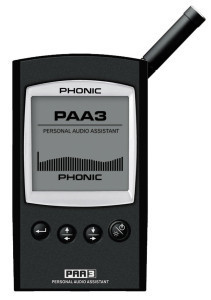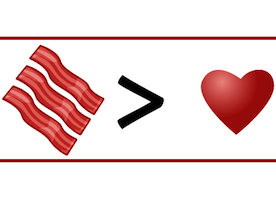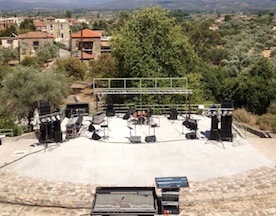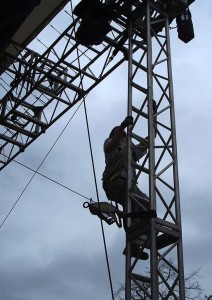Nathan Lively's Blog, page 34
November 24, 2013
Tuning vs. Toning A Sound System


 Sound engineers and production staff often confuse sound system tuning and sound system toning. Tuning a sound system involves objective goals and measurements. Toning a sound system is a subjective, artistic endeavor.
Sound engineers and production staff often confuse sound system tuning and sound system toning. Tuning a sound system involves objective goals and measurements. Toning a sound system is a subjective, artistic endeavor.
Audio can be scary because it’s invisible. Therefore, many people believe all audio engineers have identical wizard-like abilities: they are expected to walk into any room, anywhere, and create magic sound with their golden ears.
In reality, system technician and mix engineer are separate jobs. Although both use their ears and are often performed by the same person, they require different skills and goals. Let’s stop trying to combine the two jobs into one and get to work. In this post I would like to share some of the information from Bob McCarthy’s original article, Toning Your Sound System.
Sound System Tuning
Tuning a sound system: Adjust for uniform response over the listening area, with minimal distortion, maximum intelligibility and best available sonic imaging.
Bob McCarthy

The goal of tuning a system? To have the same sound everywhere. That means having the same level, same frequency response, and same intelligibility in every single seat.
Is that attainable? No. Our atmosphere is a harsh place for sound waves. But do we strive for faithful delivery to all ears? Absolutely. We know our children will never be perfect, but we love them anyway.
Tuning can be objectively measured. We have tools that we can use to measure exactly how close we are to achieving our goal, and therefore declare success. With software and hardware such as SIM, SMAART, Easera, and SATLive, we can perform a transfer function to measure relative level, delay/phase, and frequency response. Toning, in contrast, is a subjective process.
Sound System Toning
Toning a system is the setting of a bank of global equalization filters at the output of the mix console that drives the sound system. If you want to set it by ear fine. If you want to set it by 10,000 hours of acoustical analysis containing mean/spline/root squared/Boolean averaging then go for it. There is nothing at stake here. Nothing to argue about. The global equalizer is just an extension of the mix console EQ.
Bob McCarthy
Sound engineers just love to argue on forums and in trade magazines about exactly how to do this. The classic advice is to yell “Check!” into a microphone over and over while moving filters on a graphic EQ until everyone’s ears bleed, and call that success. Other engineers choose to play songs that they know well. I like pink noise because it’s fast, you can play it quietly, and has no emotional connection. The truth is, it doesn’t matter. It’s not a science and we don’t need to make it one.

Good toning enhances the musical quality, or natural quality of transmitted sound. Good tuning ensures that the good (or bad) toning makes it beyond the mix position.
Bob McCarthy
It is important to keep these concepts in perspective because audio is primarily a subjective and emotional business. We can’t see it, so even those of us who work in the field feel very strongly about what happens in this invisible space. My guess is that you’ve seen an article or two about the advantages or disadvantages of a “flat sound system.” That argument is pointless, because you can’t dance to white noise. Music is all about dynamics, not equal power per frequency band. Besides, so many other tasks come first in tuning a sound system: checking driver functionality and polarity, aiming the speakers, adjusting splay angles and relative level between speakers, setting crossovers, phase alignment, intelligibility analysis, and treating reflections. Equalization is the final step in the process.
I once worked with a sound engineer who often repeated a story of a Meyer Sound technician coming in and “SIMing the sound system,” only to have it sound terrible. I’m sure he’s right; to him it sounded terrible. But it probably also sounded terrible at every seat, because it was properly tuned. His frustration comes from this breakdown in communication about where system optimization ends and artistic expression begins. As Bob McCarthy says in our interview, “Draw me a picture of how you want it to sound and I’ll paint that in every seat. But you can’t paint on a canvas with a giant rip in it. That’s no fun.”
 Here’s a common error: Measure at 15 different places around the room. Average them together. Apply the reverse settings to your EQ. How do I know? Cause I used to do that shit all the time!! I had a hand-held RTA (real time analyzer) that would allow you to put measurements into memory, average them, then flip them to make settings to a 31-band graphic EQ. First of all, an RTA and graphic EQ are never appropriate for system tuning. (See my discussion with McCarthy below at 24m22s.) Second, it’s really important to know what is happening with your audio in different parts of the room, so averaging different areas together is misleading. As McCarthy says, “Why bother to take samples all around the room if you’re not going to do anything about the differences around the room? It’s just a waste of time.” Also, the math doesn’t work out because measurements of destructive summation (cuts) are often narrow and deep while measurements of constructive summation (boosts) are often wide and short.
Here’s a common error: Measure at 15 different places around the room. Average them together. Apply the reverse settings to your EQ. How do I know? Cause I used to do that shit all the time!! I had a hand-held RTA (real time analyzer) that would allow you to put measurements into memory, average them, then flip them to make settings to a 31-band graphic EQ. First of all, an RTA and graphic EQ are never appropriate for system tuning. (See my discussion with McCarthy below at 24m22s.) Second, it’s really important to know what is happening with your audio in different parts of the room, so averaging different areas together is misleading. As McCarthy says, “Why bother to take samples all around the room if you’re not going to do anything about the differences around the room? It’s just a waste of time.” Also, the math doesn’t work out because measurements of destructive summation (cuts) are often narrow and deep while measurements of constructive summation (boosts) are often wide and short.
Take away message: You don’t use an audio analyzer to make something sound good; you use it to make it sound the same everywhere.
Have you experienced this communication breakdown? Comment below.
The post Tuning vs. Toning A Sound System appeared first on Sound Design Live.
November 17, 2013
Sound System Design And Optimization with Bob McCarthy


In this episode of Sound Design Live I speak with Bob McCarthy, author of Sound System Design & Optimization and Director of System Optimization at Meyer Sound. We talk about variable acoustic architecture, why we must optimize before we mix, and how to prioritize our system check list. We also discuss why graphic EQs are useless, common misconceptions about stereo, the pitfalls of L/R stacked subs, why sound is so difficult to teach, tips for finding on-axis points and relative splay angles between speakers, wireless microphones for measurement, hardware and software measurement systems, and how to get what you want without humiliating the client. Hold on to your hats and bring a snack, we have a lot of ground to cover.

System optimization is dedicated to a very simple scientific concept: Not to make it sound good, but to make it sound the same. We are a waveform delivery service.
Bob McCarthy
 Details from the podcast:
Details from the podcast:
All music in this episode by Gala Drop
Bob’s website and his seminars at Meyer Sound
Bob’s forward to my eBook, Sound Design Live
Jazz At Lincoln Center, The Alan Room, Julliard
Constellation Electroacoustic Architecture
The musical Wicked, with sound design by Tony Meola assisted by Kai Harada
AES 50th conference on education: There is currently no audio or video of the conference to share, but I did get some a nice photo and Bob’s presentation slides. See below.
Why is sound so difficult?
It’s invisible.
It’s almost inaudible. [You can only experience it at the location you are right now, unlike light which can be seen at many different locations at once.]
We experience it logarithmically, but talk about it linearly. You cannot ignore the science or the art.
Sound system check list:
Basic signal flow: Correct sound out of the correct speakers. Is the cabinet wired right? Are all drivers functioning?
Speaker position: Aim, relative splay, relative spacing. Is it pointed at the right place? Is it splayed correctly compared to its neighbor? Is anything obstructing the sound?
Measurement systems: SIM, SMAART, SATLive
Sound & Video Contractor magazine
Quotes:
“The reason you can’t just go to your artistic place & start mixing is that your canvas might have a giant rip in it.”
“If you want to get your artistic message delivered, you have to go through the science to get there.”
“Never humiliate a client.”

Photo by Kelly Ford and used with permission courtesy of the AES 50th International Conference.
The post Sound System Design And Optimization with Bob McCarthy appeared first on Sound Design Live.
November 13, 2013
Stealing Athlete Nutrition Techniques


 In this last post in my series on food and drink at work, I’d like to share with you some of the diet and nutrition techniques that I’ve been introduced to while hanging out with athletes. In my interview with Wendy Jo Peterson we mentioned energy gels, caffeine, and recovery drink, and I want to say a few more things about each of those to put some new ideas in your head about eating healthy on the job.
In this last post in my series on food and drink at work, I’d like to share with you some of the diet and nutrition techniques that I’ve been introduced to while hanging out with athletes. In my interview with Wendy Jo Peterson we mentioned energy gels, caffeine, and recovery drink, and I want to say a few more things about each of those to put some new ideas in your head about eating healthy on the job.
Gatorade/Red Bull/Monster Energy
A popular slogan going around the world of athletics right now is “Hydration in your bottles. Food in your pockets.” Remember it. When you try to quench your thirst with a drink that has a lot of carbohydrates (sugar), your body actually has to take water away from your muscles in order to digest the drink — not a great way to hydrate. Stay away from calorie-and-sugar-rich energy drinks like Gatorade and Coke. It’s tempting to have a soda because they are readily available, and you may feel justified in having a Red Bull because you are working long hours, but you’ll feel a lot better on a long day if you avoid these and stick to drinking water throughout the day and eating solid food when you need to up your energy stores.
 Snack tip: For long low-intensity work, like sitting behind a mixing board at an all-day corporate event, break up your snacks. Your body can only process so much food energy at once, so if you want to get the full benefit of your food, instead of eating an entire energy bar at once, eat a couple of bites every 20 minutes. For high-intensity work, such as large load-ins, have an energy gel or another simple-sugar/low-fiber food (jelly beans, pretzels, etc.) every 45 minutes for the duration of the work.
Snack tip: For long low-intensity work, like sitting behind a mixing board at an all-day corporate event, break up your snacks. Your body can only process so much food energy at once, so if you want to get the full benefit of your food, instead of eating an entire energy bar at once, eat a couple of bites every 20 minutes. For high-intensity work, such as large load-ins, have an energy gel or another simple-sugar/low-fiber food (jelly beans, pretzels, etc.) every 45 minutes for the duration of the work.
Caffeine
Did you know that your body builds up a tolerance to caffeine? Many endurance athletes use products during competition that have caffeine in them, but that won’t do them any good if they slam espressos all the time when they’re not competing. Coaches frequently recommend that athletes have one cup of regular coffee in the morning (about half the amount of caffeine they will consume during one hour of competition), and then switch to decaf.
If you wash down your 5-hour Energy shot with a Red Bull, you’ll quickly become desensitized. You might feel a little bump, but you’ll definitely feel a big crash. Go easy on the caffeine in your day-to-day life so that when you really need that extra energy for heavy lifting, your caffeinated energy gels or espresso will actually do something for you.
Recover Faster, Work Easier
When you do physical labor, you deplete your muscles of glycogen, which is the most readily-available energy source for your body (fat is another source, but it takes longer to turn into a form you can use). After hard work, you want to replace your muscle glycogen within an hour of finishing work, when your muscles are most receptive to refueling and repair — that’s called your “glycogen window.” Athletes usually replenish using a four-to-one carbohydrate-to-protein ratio; the carbohydrate loads your muscles up with glycogen and the protein helps your muscles repair themselves. Solid foods are best for after-work recovery, but can be substituted with recovery drink when necessary. When is that necessary? For example, if you’re done working but you have an hour commute home and you forgot to bring a snack. Keep a packet of recovery mix, like GU Recovery Brew, or a shelf-stable box of chocolate milk (a lot of athletes recover with chocolate milk because it has the correct ratio and is readily available/often cheaper than fancy mixes!) in your car and drink one of them on your drive home. Then, have a real meal within three hours of finishing. Your body will thank you.
 Carbohydrate Loading
Carbohydrate LoadingCarb loading is widely misunderstood, and it’s not a free pass to eat all the pasta and bread you want (sorry). Don’t eat a big meal right before work, because it will just sit in your gut and divert energy away from your muscles for digestion. You need to allow time for the food to process through your system.
So, if you are working early in the morning, eat plenty of complex carbohydrates like whole wheat pasta, brown rice, or sweet potatoes for dinner, then have a light breakfast the next day. If you are working at night, eat a big breakfast with complex carbs like oatmeal or whole-grain pancakes, and then a light lunch. The idea is that your body needs several hours to make your food available for action, and whatever you eat right before work won’t have enough time to actually to help you work, it will only draw energy you need to do your job into your digestive system. If you work with musicians or actors, you may have noticed that they like to eat dinner after the show, not before. This is why.
Also remember, it’s called carboHYDRATE for a reason — it helps your muscles store water and remain hydrated, so it is important that you drink a bunch of water with your major pre-game meal.
Food Diary
If you really want to dial in your nutrition, keep a food diary. Note how you feel at regular intervals in the day and see how that relates to what you eat. Did you feel really weak at the end of the day? Maybe you didn’t eat enough overall. Did you feel tired at the middle of the day? Perhaps you ate too big a meal right before starting work that made you feel sluggish. Did you feel rested the next morning? A diary will help you remember what you ate during your glycogen window and increase it next time.
Future Food
Now accepting human trials.
 Soylent: Have you heard of this kid in San Francisco who has stopped eating food? Instead, he is drinking a food substitute. Meal substitutes have been around for a while, but this is intended to supply all of the human body’s daily nutrition. As you can imagine, it’s very controversial. The original article is How I Stopped Eating Food. Not sure if that one will be up forever because they raised $1,000,000 on KickStarter and are now selling direct on this site. Please let me know if you try it in the comments below.
Soylent: Have you heard of this kid in San Francisco who has stopped eating food? Instead, he is drinking a food substitute. Meal substitutes have been around for a while, but this is intended to supply all of the human body’s daily nutrition. As you can imagine, it’s very controversial. The original article is How I Stopped Eating Food. Not sure if that one will be up forever because they raised $1,000,000 on KickStarter and are now selling direct on this site. Please let me know if you try it in the comments below.Noni juice: Produced mostly in Tahiti and Hawaii, the Polynesians have been using it has a remedy for over 2,000 years. With no scientifically proven health benefits it is, again, very controversial. I’ve been trying it for a month, but haven’t developed the super powers I expected. I’ll let you know, or you’ll just read about me in the news.
Honey: Honey is organic and virtually indestructible. It can be used to help you sleep and treat heartburn. It’s also basically bee vomit and it has been shown to have no nutritional value over table sugar. Keeping with the athlete theme, Tour de France champion Greg LeMond (who had a huge sweet tooth) says that the difference between sugar and honey is that one sticks to your teeth.
Chia seeds: These little seeds became popular alongside the barefoot running craze when the book Born to Run came out. They’re supposed to be an Aztec superfood that make you feel full for a long time and help you run long distances. Some athletes mix them with water or fruit juice in a flask to make their own custom energy gel.
What are some of your favorite food tips?
Great thanks for the considerable input from Elis Bradshaw.
The post Stealing Athlete Nutrition Techniques appeared first on Sound Design Live.
November 6, 2013
Behind Moldover’s Kickstarter Success


In this episode of Sound Design Live, I talk with musician and electronic instrument maker Moldover about the Kickstarter campaign for his new album. Moldover shares the mistakes he made with his first album and the important changes he is making this time around. We also discuss the new hardware he’s working on, in-ear monitors, and the importance of tragedy in art.

Get as many people involved as possible.
Moldover
Details from the podcast:
 All music in this episode by Moldover
All music in this episode by MoldoverDonate to the Kickstarter !
Pebble Watch
Sound Design Live eBook
Moldover’s last album with a built-in light theremin
NAMM = National Association of Music Merchants
Ultimate Ears In-Ear Monitors
DAW = Digital Audio Workstation (like Cubase)
UAD DSP hardware
TED talk about tragedy in art – What’s A Kinder Way To Frame Success?
The post Behind Moldover’s Kickstarter Success appeared first on Sound Design Live.
November 3, 2013
BOOK REVIEW: Mediterranean Diet Cookbook For Dummies


 I follow Wendy Jo Peterson on Twitter (@FuelinRoadie) because she is the the only nutritionist I’ve come across who works specifically with musicians and live event crew. As part of my series on food and drink at work, I decided to review her book, Mediterranean Diet Cookbook For Dummies. The few things I know about cooking I picked up from friends and family, and this is the first cookbook that I’ve owned and used. It’s easy to read; each recipe is simple and straightforward, requiring only a few steps. Let’s jump right into some of Wendy’s best meals to take to work:
I follow Wendy Jo Peterson on Twitter (@FuelinRoadie) because she is the the only nutritionist I’ve come across who works specifically with musicians and live event crew. As part of my series on food and drink at work, I decided to review her book, Mediterranean Diet Cookbook For Dummies. The few things I know about cooking I picked up from friends and family, and this is the first cookbook that I’ve owned and used. It’s easy to read; each recipe is simple and straightforward, requiring only a few steps. Let’s jump right into some of Wendy’s best meals to take to work:
Best Recipes To Take To Work
Frittata
I love meals that last for days, and this is definitely one of them. If you’ve never made one, they are super simple. Basically, you just sauteé whatever veggies you like and throw a bunch of eggs on top. I like to make a big one for the week and heat up a slice in the morning. You may or may not enjoy this cold, so it’s best to make it when you have a microwave at work.
The first recipe I made from the cookbook was the Goat Cheese Fritatta, which was great, but I had to double the salt, pepper, and garlic to suit my tastebuds. This makes me think that the seasonings in these Mediterranean recipes might be toned down to please bland American palates.
Salad
Salads are great to take to work, but they wilt and taste like crap when they are hot, so if you are going to be outside take an ice pack with you. In the last post I mentioned Wendy’s salad in a jar, which is a great way to prepare salads ahead of time and keep them fresh. Don’t forget to include nuts and beans for added protein. And fruit salads! There is a recipe for Pomegranate Salad in the book that looks great.
If you want to turn your salad into a more substantial meal, add salmon or tuna (or tofu for vegetarians). If you want to please your stomach with more carbs, add pasta.

Couscous and Polenta
Couscous and polenta keep well in the fridge for days. I included a great couscous recipe in my last post, Eat Healthy On Tour. Polenta will congeal when not kept warm, so you can just cut off a slice and pop it in the toaster. Peterson includes a recipe for Polenta with Prosciutto and Parmesan, but I like to use mushrooms and onion instead of prosciutto.
Beans
The cookbook includes several recipes with beans that would both taste good cold and be fine to carry around, including Black Beans with Tomatoes and Feta. The secret ingredient for most of these recipes is feta cheese. Yum.
Wendy suggests eating protein-rich food together with a bit of fat to slow digestion at meals. As you can see, all of the above recipes can be modified to have more or less protein and fat. The other recipe from this cookbook that I tried out myself was Grilled Scallops. Scallops are great! They are a little expensive and might be hard to find fresh in your town, but they are super easy to prepare on a grill or in a pan and make for a very impressive meal.
The Mediterranean Lifestyle
Research has shown that people who live in these areas have less heart disease and better longevity.
This book is more than a cookbook; it also includes a nice survey on the Mediterranean lifestyle and its health benefits. This is important because heart disease is the number one cause of death in the US. There is a great story in Malcolm Gladwell’s book Outliers about Roseto, a US town that in the 1950s was heavily populated by Italian immigrants and had an incredibly low rate of heart disease compared with the rest of the country. After researchers exhausted all other hypotheses about diet, exercise, and location, they discovered that it was the community itself that made people more healthy. You can read the entire story here. Along with nutrition, Peterson’s cookbook covers some of these intangible qualities of work-life balance in her attempt to describe the Mediterranean lifestyle.

Mediterranean diet is a way of life – one where you eat lots of fresh food and slow down.
Wendy Jo Peterson
I experienced a version of Mediterranean diet while I lived in Portugal 2003-2008. While Wendy recommends eating seafood and drinking wine a couple of times a week, I’m thinking, people in Lisbon do this for every lunch and dinner! Woohoo! That’s because you can eat a complete fish lunch for the same price as buying the fish yourself. And you can get a bottle of great local wine for $4. Portugal doesn’t have a siesta after lunch like Spain, but you usually get an hour off for lunch and having alcohol with your meal isn’t taboo. (Speaking of taboo, did you know that Portugal decriminalized all drugs ten years ago? Apparently they’ve reduced national drug addiction by half. Read about it here.)
Mediterranean Diet Cookbook also has good information on incorporating more plant-based foods into your diet. This is important to me because I eat mostly vegetarian, but also because I recently watched the documentary Knives Over Forks. If you haven’t seen it, it basically blames meat and dairy for cancer. Polarizing much?
Conclusion
When I started reading this book, I thought: “I’m going to find some fast easy recipes for busy sound engineers.” In the end I found a lot more value in the recommendations for relaxation and stress reduction. There is much more to the Mediterranean lifestyle than just olives and wine. It’s gathering for food with our friends, family, and community that really reenforces our human connections and emotional balance.
Do you have a Mediterranean style life-hack?
For more about how to recover from a long work day, the best snacks for instant energy, and nutrient-rich meals for the road, listen to my entire interview with Wendy Jo Peterson.
The post BOOK REVIEW: Mediterranean Diet Cookbook For Dummies appeared first on Sound Design Live.
October 27, 2013
Healthy Eating On Tour


 Anyone who has been on tour knows how tough it is to eat healthy on the road: you eat out for every meal, which usually means fast food. Fortunately there are smart choices you can make, as Wendy Jo Peterson points out in her article Healthy Eating On The Run. In this post I will cover the two tips from Peterson’s original article that are most applicable to sound engineers. For more from Wendy Jo Peterson, listen to my interview with her, Food And Drink At Work For Sound Engineers.
Anyone who has been on tour knows how tough it is to eat healthy on the road: you eat out for every meal, which usually means fast food. Fortunately there are smart choices you can make, as Wendy Jo Peterson points out in her article Healthy Eating On The Run. In this post I will cover the two tips from Peterson’s original article that are most applicable to sound engineers. For more from Wendy Jo Peterson, listen to my interview with her, Food And Drink At Work For Sound Engineers.
Make A Plan

Think ahead. Plan where you will eat and consider what meal options are available. Look for restaurants or carry-out with a wide range of menu items.
Wendy Jo Peterson
Eating healthy will be easier down the road if everyone is on the same page from the start. Bring up the topic of food at the very first pre-tour meeting. One or two naysayers can easily derail group decision making, so it is better to have issues come out early in the game instead of right before dinner. Some people, especially actors, might want to always eat after the show; you’ll have to work that timing out. In my experience those people are in the minority and have no problem getting their food to go when everyone else eats before the show.
If you are on a small tour, then the tour manager is also likely the bus driver, the technical director, and the drummer. That means they won’t have time to organize every meal. Offering to find a couple of meal options in each new city means that you won’t end up eating burgers night after night. The best strategy is to find two or three different restaurants with healthy options and carry-out within a block of each other so that there will be something to satisfy everyone. Tools like Yelp and UrbanSpoon can simplify the process. Just figure out where you will be around lunch time and put that location into Yelp. Afterwards, build good karma by writing a short review of those places with notes for other tourists.
Making a plan also means preparing some meals ahead of time, for when things run late. For snacks, bring a bag of your favorite fresh or dried fruits and whole-food bars (Kind Bar, Laura Bar). For a true meal, try a protein-rich sandwich with hummus and sprouts or a salad in a jar. What is salad in a jar? Take a mason jar and layer dressing on the bottom, dense veggies or beans next, then light or leafy vegetables, and pasta or potatoes on top. When it’s time for lunch, just shake it all up and eat it. Want more ideas? Listen to the entire interview:
Make Smart Restaurant Choices
No matter where you end up eating, you can make smart choices with any menu.
Menu terms that often mean lower fat and calories: baked, braised, broiled, grilled, poached, roasted, steamed.
Menu terms that often mean more fat and calories: batter-fried, pan-fried, buttered, creamed, crispy, breaded.
Go easy on the booze. Alcohol tends to increase your appetite and provides calories without any nutrients. (Drinking alcohol reduces your blood sugar level, therefore fooling your body into thinking that it needs more food.)
A baked potato offers more fiber, fewer calories, and less fat than fries as long as you skip the sour cream and butter. Top your potato with broccoli and a sprinkle of cheese or salsa. (I LOVE FRIES! That is all.)
Go easy on the sour cream, cheese, mayonnaise, tartar sauce, guacamole, bacon, and other high-fat toppings. (Fries need sauce! Damn it!! Oh, apparently ketchup is okay.)
Try a smoothie made with juice, fruit, and yogurt for a light lunch or snack. (I wish there were a JambaJuice next to every place I worked!)
Bonus Recipies
Here are a couple of great meals that I make regularly and take to work with me. See the full article at Super Easy Meals That Last You For Days.
 SANDWICH
SANDWICHCarbohydrates: Bread
Protein: Meats (turkey, ham), Cheese (gouda), Hummus
Vitamins: Avocado, Tomato
COUSCOUS MEDLEY
Carbohydrates: Couscous
Protein: Meat/Cheese (tuna)
Vitamins: Crunchy (vegetables)/Soft (fruit)
Dressing: Olive Oil, Lemon Juice
To prepare: Make Couscous, chop vegetables and fruit, mix everything
Cost: About $10
Value: About 3 meals
As you can see, this recipe is simple and flexible. Grab whatever fruits and vegetables you like at the store, then mix to taste. You can also substitute healthy nut oils (pumpkin seed, hazelnut, walnut, etc.) for the olive oil and balsamic or sherry vinegar for the lemon juice to change up the dressing. For an Asian-inspired dressing, try a little toasted sesame oil and seasoned rice vinegar. A dab of mustard will help prevent your dressing from separating.
What are your favorite ways to eat healthy on the road?
The post Healthy Eating On Tour appeared first on Sound Design Live.
October 20, 2013
Food And Drink At Work For Sound Engineers


On this episode of the Sound Design Live Podcast I speak with Wendy Jo Peterson about making good food and drink choices at work. We discuss the best snacks for instant energy, nutrient-rich meals for the road, and common food myths. We also talk about how to recover from a long work day, nutrition apps, and how to analyze your urine to determine your de/hydration level. Hurray!

When you start to feel thirsty you are 2% dehydrated and at 4% you’re at risk for death.
Wendy Jo Peterson
Details from the podcast
All music by Gala Drop
Wendy Jo on Instagram and Twitter
Aioli is a sauce made with garlic, olive oil, lemon juice, and egg yolks.
High glycemic (i.e. high calorie, high simple sugar, fast energy) snacks: Energy Gels (instant energy), Justin’s Nut Butters, honey (could spike the gut, better for off-hours)
Moderate glycemic snacks with complex carbohydrates (less likely to make you crash): Greener banana, apple, orange, grapes, roasted sweet potato w/lime zest, Kind Bar, Laura Bar
Food at work:
Protein rich sandwich with hummus and sprouts
Almond butter with apple slices
Salad in a jar: dressing on the bottom, dense veggies or beans next, more leafy vegetables, pasta or potatoes on top, shake it, eat it. See more about this on Wendy’s video about bus-friendly foods.
Greek yogurt with goji berries and chopped nuts
Recovery nutrition: Take 30min to get a good meal instead of heading straight to snacks and alcohol. Substitute with a shake or nutty trail mix.
Galeria Zé Dos Bois
Food Apps: Foodicate, Calorie King, MyFitnessPal, My Daily Plate
Bright yellow or brown urine in the afternoon = too many supplements and possible dehydration
CSA = Community Supported Agriculture. $25/week approx. for a huge box of organic produce. Search at Local Harvest.
The Dirty Dozen: Fruits and vegetables you really should by organic.
Quotes
“Find a bar that has less than seven ingredients.”
“I understand the necessity for [powders/bars/gels], but on the whole, try to go for whole foods as much as you can.”
The post Food And Drink At Work For Sound Engineers appeared first on Sound Design Live.
October 6, 2013
The State Of Sound Engineering In Greece



Dimitris Sotiropoulos is a Greek sound engineer who has appeared on Sound Design Live in How To Use Plugins with an Analog Console And Wireless Control, How Much Do Live Sound Engineers Make?, and Sound Design Live Podcast Greatest Hits Volume 1. He is a good friend, a great engineer, and I really appreciate his views on business, audio, and life. In this post he describes the prerequisites for being a successful sound engineer and gives us a detailed look into how the ongoing economic crisis has affected his work.
Nathan Lively
Job Description Working as an audio engineer is a life-long commitment. Money does come, but at a toll. Many engineers out there find it difficult to combine the profile of a hardworking sound guy with a great social dude, friend, and lover. So the question might be: The harder one works, is there more for him to earn, learn, or burn? The answer changes every day. Working at a mix console and working as a bank teller just aren’t the same. Enjoy at your own risk!
Working as an audio engineer is a life-long commitment. Money does come, but at a toll. Many engineers out there find it difficult to combine the profile of a hardworking sound guy with a great social dude, friend, and lover. So the question might be: The harder one works, is there more for him to earn, learn, or burn? The answer changes every day. Working at a mix console and working as a bank teller just aren’t the same. Enjoy at your own risk!
You need:
Social Skills: Part of the trade is marketing yourself. What service are you offering to perspective clients? This is an important part of the job, along with the knowledge and experience to carry out any given project. Social skills are indeed essential to hooking up and connecting with people…um, sorry, I mean clients.Audio Awareness: Knowledge comes from research and experience. Knowing the dos and don’ts gives you a great starting advantage. Speaking into a 58 to fine tune a sound system isn’t a skill learned from karaoke and isn’t written in any book or blog. Reducing frequency masking in a mix isn’t a formula you learn, it requires personal experience that you develop through ultimate failure and successful attempts to make it sound great. Never forget to listen. Never forget to read. Don’t get too caught up in gear debates. It takes time away from the hands-on experience which is very important. Touching is always better than imagining (um….that didn’t sound right). We all know what a Fairchild comp does, it smooths the peaks and plays with the curves, but chances are only a few of us will ever get to touch one.Eclectic Experience: Throughout the last 15 years or so, I have done everything from performing, to making coffee, to building Dexion shelving, to soldering cables, to finally recording and mixing.Times Have Changed In Greece My point of view at the moment is impaired, due to the huge economic disaster that has stricken Greece over the past four years, with actual unemployment way above the officially-measured 27.4% today.
My point of view at the moment is impaired, due to the huge economic disaster that has stricken Greece over the past four years, with actual unemployment way above the officially-measured 27.4% today.
Once upon a time, I had several studio projectsg as an engineer at one of the main studios in Athens during the day (10:00-22:00), worked FOH at night clubs on weekdays (23:00-xx:xx), and spent my weekends around the country on tour. That was, of course, as much as a single person can endure in terms of time (sadly there are only 24 hours in a single day) and physical/mental exhaustion was common. I would sleep everywhere but my bed: couches, tour bus seats etc. That was my maximum. As a reference, if you divide, subtract, and multiply, it all averaged out to 350-400€/day, everyday, which was a solid amount of money to live off of in this small and blessed country. My rates could have been much higher, but you get paid what you negotiate. I’m good at what I do, according to some people, but I’m not good at negotiating, according to me.
Nice memories, but I don’t see these times coming back anytime soon. I am still committed to the work, but now must settle for much less.
The live work I take these days offers anywhere from 100€ το 400€ depending on how large the “pie” is to cut.
For the past three summers I have been mixing stage monitors for a well known Greek duo which currently pays 300€ per event (I was offered the job in 2011 for 400€), plus expenses, and involves making sure everything is set up as expected on stage, ringing out the monitors and side fills, sound checking the band without the artists, and finally running the show for two or so hours with everyone happily entertained. Pretty typical for this part of the world and a job I enjoy even though this summer the dates booked were very limited.
Most winter live gigs take place in bars or small cafes nowadays. They involve more work setting up, running cables, and doing both FOH and Monitors for 3-4 people, and are often a challenge. I usually expect sub-par equipment, faulty cables, and substantially less pay. The challenge to overcome problems and troubleshoot the setup is a rush, I can tell you that. (Negotiated fees can range anywhere from 100-250€ per event.)
I try to take any audio related project in this present time since we’ve been in free fall — the economy, that is — these past years. Here are some examples of summer projects:
Renting out some of my studio equipment to setup a remote recording location in a country house for an album’s pre-production sessions. (Negotiated 1500€ fee.)Rewiring a studio, which reminded me how challenging it can be to get the normaling right on the patchbays, keep cable lengths to a minimum, and satisfy my OCD to have everything as neat as possible. It took me 10 days to get it up and running to minimum prerequisites. Then again, it was only me and a soldering iron. Then I need a week or so to wrap it up with no more downtime. (Negotiated 150€ per day.)Taking up a sound design project for a cosmetics company’s social media video campaign. (Negotiated 600€ fee.)Recording a three day festival in Athens as a backup recording engineer. Suntan lotion was not provided. (Negotiated 350€per day.) Organizing and putting a complex stage plot and rider together for a concert on an island in the Ionian Sea with limited resources, programming four shows for both Avid Venue Consoles (FOH-Monitors) for the two acts at night on the boat trip there, and recording the first act via direct outs from the monitors console to my HD Rig (32ins). A nightmare of timing and organization. (Badly negotiated 300€ plus expenses.)Booking a week-long lockout recording session next month. (Negotiating 1500€.)
Organizing and putting a complex stage plot and rider together for a concert on an island in the Ionian Sea with limited resources, programming four shows for both Avid Venue Consoles (FOH-Monitors) for the two acts at night on the boat trip there, and recording the first act via direct outs from the monitors console to my HD Rig (32ins). A nightmare of timing and organization. (Badly negotiated 300€ plus expenses.)Booking a week-long lockout recording session next month. (Negotiating 1500€.)Times are tough in Greece. I find it hard to maintain good rates. Prices have gone down really fast. For example, a job that used to pay 150€ or 500€ now pays 100€ flat, take it or leave it. Most of the time it’s a tough decision to take low paying jobs because of what it does to rates. Then again, there is always gonna be someone out there who is willing to do the job cheaper. When I offer my “crisis struck” discounted rates at 250-300€/gig for larger events, there is always someone willing to do it up for 80€. Intense competition powered by poverty is driving down both quality and prices. Although work just feels like survival some days, sound engineering is what I do, and I try to do my best every time.
The post The State Of Sound Engineering In Greece appeared first on Sound Design Live.
September 29, 2013
Make A Living As A Sound Engineer, Part Two: How To Get Played


In the last article we looked at proactive steps that sound engineers can take to demonstrate value and make money. Now let’s take a look at some common ways to lose money in the exciting conclusion to Stevie Weenie’s Making A Living As A Sound Engineer, Part One: How To Get Paid.
PART II: HOW TO GET PLAYEDClients With Unlimited Demands + Zero Technical Audio Vocabulary example 1: broke actor
example 1: broke actorProblem: She is starting a solo show and needs a soundtrack that feels like a Disney movie with a full, sweeping, majestic symphony. She goes to the shows carrying her entire show in a camping backpack including set, costume, props, lighting and her portable CD player. She asks you to compose, record, mix, and master two hours of original music, for 50€.
Solution: ARE YOU INSANE IN THE MEMBRANE? If you are in love with this girl and you want her to be your girlfriend, or you secretly want to quit audio, become an actor with her, and run away to join the circus, then take this gig. Otherwise, pull her camping backpack over her eyes and run the other direction as fast as you can.
example 2: backstabbing gossipProblem: A small local theater company is performing the time-honored tradition of a one-man Hamlet production. The egomaniac actor-director-producer wants a CD with backup voices to be the ghosts and FX, etc. His budget is worth two hours of your time. Five hours into the project you’re nowhere near finished and the guy keeps adding new ideas. You pull the plug and give him whatever you’ve got after six hours and refuse to take on anything else. The director bad-mouths you to all your common friends, e.g. “We got a bad result because the sound guy is a pussy.”
Solution: Never work with this person again. Next time anything like this comes up, ask more specific questions to define the project up front…or else.
example 3: the stoner piggyback scamProblem: I’ve got a regular gig doing live sound, but no studio. A friend-of-a-friend has a semi-pro home studio with no live room. He proposes that we start multi-track recording the bands so he can mix the audio at home and we can sell the recordings to the musicians for their demo CD.
Solution: Sorry, I’m on the other line with Dr. Spock. He accidentally did the Vulcan death grip on his dick in the shower and now he needs me to airlift Smurfette to the Starship Enterprise so she can administer mouth to mouth CPR, and I have to hold the boom mic for the cameraman who’s making a trailer for the full length anime porn of it all.
Translation: You’re in outer space, man. These broke, starving amateur bands come here to GET PAID, not to pay me for even so much as a 2mix off the board, and they will definitely no way in hell ever pay YOU a cut.
These next two examples have no solutions. They are just shitty situations to avoid.
example 4: rotten fish can not become sushiProblem: A local website makes promo videos to show off their best advertisers; it looks like a thriving business. They want a soundtrack for one of the promo shorts. Location sound was recorded next to a construction site and is unusable. The actors are from another country and are not available to re-record. The client wants you to “clean up” the voices and make a soundtrack. The job is impossible from the start…and as soon as you agree to take the job, all the problems become your fault.
Result: By the time you finally finish, you’re way underpaid, they’re unhappy, and they forget to give you credit on screen and send you a final copy (both of which they promised to do).example 5: unethical practices
Problem: Video producer has a contract to record a pianist for a one-minute commercial. I ask, “do you have the music prepared already?” They say yes. As soon as the session starts, the director doesn’t like the music. He says crazy stuff like, “can you play it fifteen percent less happy?” and “play it higher” (meaning louder). It takes four hours and still no result. Their budget was enough for one hour.
Result: They completely lied about having the music ready and they blame the pianist. Ridiculous nonsense.INCOME VS. QUALITY OF LIFE
 Before you even touch the concept of making a career as an audio engineer, make sure you really define what you think of as success. If you’re a creative person in any way, this business is probably not for you. Audio engineering, especially live sound, is for practical, technical, patient people who are capable of putting up with incredible amounts of bullshit on a daily basis (…without losing their temper or applying a blunt object to the skull of the perpetrator-of-insanity who is red-faced, pinching your arm and hissing “don’t fuck it up” in your ear at the exact moment when you are in the process of perfectly not fucking anything up).
Before you even touch the concept of making a career as an audio engineer, make sure you really define what you think of as success. If you’re a creative person in any way, this business is probably not for you. Audio engineering, especially live sound, is for practical, technical, patient people who are capable of putting up with incredible amounts of bullshit on a daily basis (…without losing their temper or applying a blunt object to the skull of the perpetrator-of-insanity who is red-faced, pinching your arm and hissing “don’t fuck it up” in your ear at the exact moment when you are in the process of perfectly not fucking anything up).
I make about half my monthly income from DJ’ing and the other half from doing live sound and program management for a youth hostel that has a live sound venue in it. There were times when I was spending five nights a week there and not really DJ’ing for money (only for fun). I’ve recently changed that, because doing sound in a hotel means you are in the restaurant business, not the music business.
In Prague, rates look like this:
50€ to do live sound for one concert in a small club using their gear.75€ to be soundman for one night at a club with two stages, two bands, and one DJ crew.250€ to do sound for a show where you bring mics and an FX rack.200-400€ for a wedding gig where you bring the sound system and DJ.50€ per musician for a band.But it needs to be said again and again: this is not a business you get into for the purpose of making a predictable monthly income. You do it because you have skills that people need, you have a network of friends who ask you for help, and you like being out at night.
END NOTESFriendliness is absolutely the most essential thingPeople with sound problems are like wounded animals. You have to treat them gently and solve everything without making it worse.Live sound: When you do it perfectly, nobody notices. When someone on stage screws up, you get blamed. Be ready for that.You can’t blink or close your ears. That’s why sound is so important.If you want to have a career at all, just keep doing what you enjoy. The rest will fall into place.Thanks everyone. I know you sound guys read kinda slow, so I made sure not to type too fast.

peace
steve
The post Make A Living As A Sound Engineer, Part Two: How To Get Played appeared first on Sound Design Live.
September 27, 2013
Make A Living As A Sound Engineer, Part One: How To Get Paid


 Hello everyone! This is guest writer stevie weenie, coming at you from Prague. I went through audio engineering school with your indestructible host Nathan Lively, who asked me to share some thoughts about making a living as a sound engineer.
Hello everyone! This is guest writer stevie weenie, coming at you from Prague. I went through audio engineering school with your indestructible host Nathan Lively, who asked me to share some thoughts about making a living as a sound engineer.
The most important thing you need to learn about building your career as a sound engineer is how to recognize which situations will lead to money — and which won’t!
PART ONE: HOW TO GET PAIDBE OBSERVANTIDENTIFY SPECIFIC PROBLEMS THAT EXPLAIN BAD SOUNDMost venues with sound problems know that something isn’t right, but they have absolutely no clue what the problem is. By the time they call you they’ve spent a ton of money on expensive fixes that didn’t help. If you can find simple, cheap solutions that make a dramatic improvement in the sound, you get the cookie. You would not believe how often a lovely pro audio system is spoiled by one weak link.
 example 1: surround sound madness
example 1: surround sound madnessProblem: DJ’ing a one-off gig at a new sports bar with a stage for live bands: it is a mess. The IT guy who built the sound system had the right parts but all the wrong connections. The FOH sound goes from a mixing board up on the balcony, DOWN AN UNBALANCED RCA CABLE TO THE BAR, into a surround-sound amp, through a digital processor (adding a 250ms delay to everything), then back to the speakers. The stage monitors are basically a quarter-note out of sync with FOH sound. Bands are physically unable to play their instruments because the FOH sound is so badly delayed.
Solution: Bypass the entire surround sound amp. Send the main L/R mix back through the snake to the stage box, extend XLR cables to a line splitter, and run all six amps in stereo with a mono sub. Install an A/B source switch-box at the amp rack to choose between the bar’s surround receiver-amp and the live mixer sound as inputs.
Result: Regular job as house soundman.
example 2: gain staging from hellProblem: “It always comes out at the wrong volume.” I look in the rack. I see unbalanced Y-adapters plugging two sources into each amp input! They were amplifying an iPod with its volume at 15%, plus a Sky TV system with its volume at 85%, and asking me for a compressor to keep it at the right level. Oh jeez…
Solution: Plug only single balanced connections into the amps. Recognize you are dealing with a human problem, not a technical problem. Tell the bar staff “This big knob with the blue light is for the volume control, you don’t need to touch anything else.”
Result: Flirt with the blonde waitress and go home with money in your pocket.
example 3: surround sound medieval torture chamberProblem: Basement restaurant has four small rooms and one surround sound unit to power them all. Their speaker cables are all pigtail spliced together and rammed into the speaker jacks. They are using the”Back Left” speaker jacks as a stereo pair for the back room! They wonder why it sounds weird.
Solution: Grab the receiver’s model number off the faceplate, download the PDF owner’s manual and look up how the LED display relates to the audio going out to the speaker jacks. Set up the system to run in “all channels stereo,” tighten up the cable splices, and solve their problem. Then I write notes for the bar staff about which button to press on the stereo to get it working again.
Result: They pay your invoice, offer you a free breakfast and call you back again next time they need something. It might not be enough to live on, but this is building your network and in the end, that’s what keeps you alive. Which leads us to the next point:
DON’T BE AN ARROGANT DICKMAKE RECOMMENDATIONS THAT PROVE THAT YOU KNOW WHAT YOU’RE DOINGUsually the boss is fed up with getting ripped off, so he wants somebody who knows what is going on and he doesn’t want any questions. Your job is to fix the problem, then go away. If you start complaining, you become one more person on his list of useless people to fire ASAP. You cannot survive in this business unless you make life easy and pleasant for your clients.
example 1: the soundman vs. “the architects”Problem: An expensive hotel builds a music stage in the bar where there are flat concrete walls, ten-meter ceiling, hardwood floors, GIANT PLATE GLASS WINDOWS PARALLEL TO EACH OTHER. Check out the photos below. The complaint is that the press is giving them reviews of “bad sound”. The owners have been asking their architects to fix the acoustics, the answer comes back 10,000€ for ceiling panels and one custom-stitched thin velvet curtain on the back wall of the stage. You know this will not work.
Solution:
Be professional and don’t laugh at what other people suggested.Suggest simple, cheap, non-destructive solutions that are easily reversible if they change their mind.Put a carpet on stage.Hang some curtains over those plate glass windows.Get some portable acoustic absorber panels on the back wall of the stage.Result: In the end the bosses take your advice because your ideas made sense to them, you removed their fear of permanent damage, and your solutions are thousands of Euros cheaper than what the architects said.


Problem: A club owner spends 2500€ on expensive sound treatment for the room. He goes on to connect a computer, satellite TV, unbalanced mics and a cheap four-channel mixing board through a DJ mixer, all buried under a pile of ashtrays in the DJ booth. He uses booth/zone output jacks from the DJ mixer to control the different rooms in the bar. He doesn’t know why it sounds like crap and wants to buy a subwoofer to fix everything.
Solution: In this case, if you tell the boss he’s an idiot for spending all that money on acoustics, you’re gonna have a problem. What you do is quote him a price that includes the subwoofer and a new mixing board to unite all the sources. Use the new mixer to feed all the amps and run the DJ mixer into it on a stereo channel. Bump the price up enough to include balanced cables on top of your fees, and don’t say peep about the previous mistakes.
 Result: They ask you to train the staff on how to use it, everyone likes it because it’s easier now, and you end up with another working relationship for ongoing tech maintenance.
Result: They ask you to train the staff on how to use it, everyone likes it because it’s easier now, and you end up with another working relationship for ongoing tech maintenance.
(By the way: if you’re in the music business you are either working to sell alcohol or you’re working for drug dealers. The people who think they’re gonna be on a Midas desk for a road touring company with Aerosmith are like saxophone players in music school who say they will never do a wedding.)
FIGURE OUT WHERE THE MONEY COMES FROMGIVE THEM WHAT THEY WANT AND SHUT UPAt every step the question is the same — where does the money come from? From people buying drinks at the bar? Sunday brunch? Fast turnaround for video? A stoner dream of nonsense?
example 1: restaurant dining roomProblem: An expensive bar wants music 18 hours a day. It could be a DJ, playlists, anything; their clientele gravitate toward the atmosphere. Boss uses a battery-powered wireless instrument mic (TS unbalanced) going into the headphone jack of a DJ mixer and over to a receiver at the bar. He complains that it’s too hard to set up and there’s too much bass in the ceiling speakers.
Solution: This one requires some finesse. Dress clean when you go in to talk with them. Seriously! Make a service agreement with your friend who owns a record shop. Your friend books classy DJs, you install a pair of wireless DI boxes with 12V adaptors, and you enjoy a nice working relationship with a posh hip new spot.
Result: The bar manager passes out free slivers of prosciutto, and the people keep buying champagne. Bingo. Your professsional network grows.
example 2: dreamy video soundtrackProblem: Video producer calls and asks, “can you make me a thirty second piece of music for a commercial soundtrack? It should sound energetic and young and jazzy. The budget for the music will pay half your monthly rent. Can you do it by tomorrow?”
Solution: HELL YES! You crank out an eight-bar piano loop with some minor seventh chords and a simple half-funky bassline, drop a beat loop on it from your sample library, hit some reverb, bounce out a stereo mix, and send it the same day for comments. The producer asks for a few easy changes. (THEY NEVER LIKE YOUR FIRST VERSION.)
Result: You make the edits, return it the next morning and get paid. This falls into the category of “nice work if you can get it.”
 example 3: star-struck managers
example 3: star-struck managersProblem: Budweiser books your home venue to shoot a commercial. The boss loves it, he’s taking in two days’ normal income for what will become literally three seconds in a beer commercial. He doesn’t know enough to ask if they plan to use location sound. He doesn’t know anything about lighting, one-day property lease agreements, or any of the stuff their crew expects to see in a normal day. Budweiser comes in with a generator truck, a million watts of lighting, catering, a pile of extras and a pro film crew.
Solution: You spend the day climbing your truss to turn off the moving gobo lights because their soundman can hear the fans. You silence phone ringers, printers, espresso machine steam hiss, and ice machine internal avalanches. You crawl around under the bar to turn off the refrigerators because they buzz. You turn off the fire alarm and illegally bypass it because their lighting rig sets it off every five minutes. You smile at the extras and get dissed at the catering truck; you even find a color printer for the director’s PDF of the script for his next project.
Result: In the end, you prevent catastrophic failure and get ignored by the honchos. One peon thanks you for saving his ass — it’s the location scout. Anyway, you charge your boss triple your normal day rate and go turn all the refrigerators back on.
CONCLUSION: Please be mentally smart inside your brains and notice that in nearly every example, the goal you are going for is not quick cash, it is to grow your network. Success depends on people; this is so obvious that most people miss it. After the first few years, most of your new business comes from your network, by recommendations and personal contacts. When you solve problems for other people, you get paid, and that’s the last word.
Next read Make A Living As A Sound Engineer, Part Two: How To Get Played.
The post Make A Living As A Sound Engineer, Part One: How To Get Paid appeared first on Sound Design Live.




